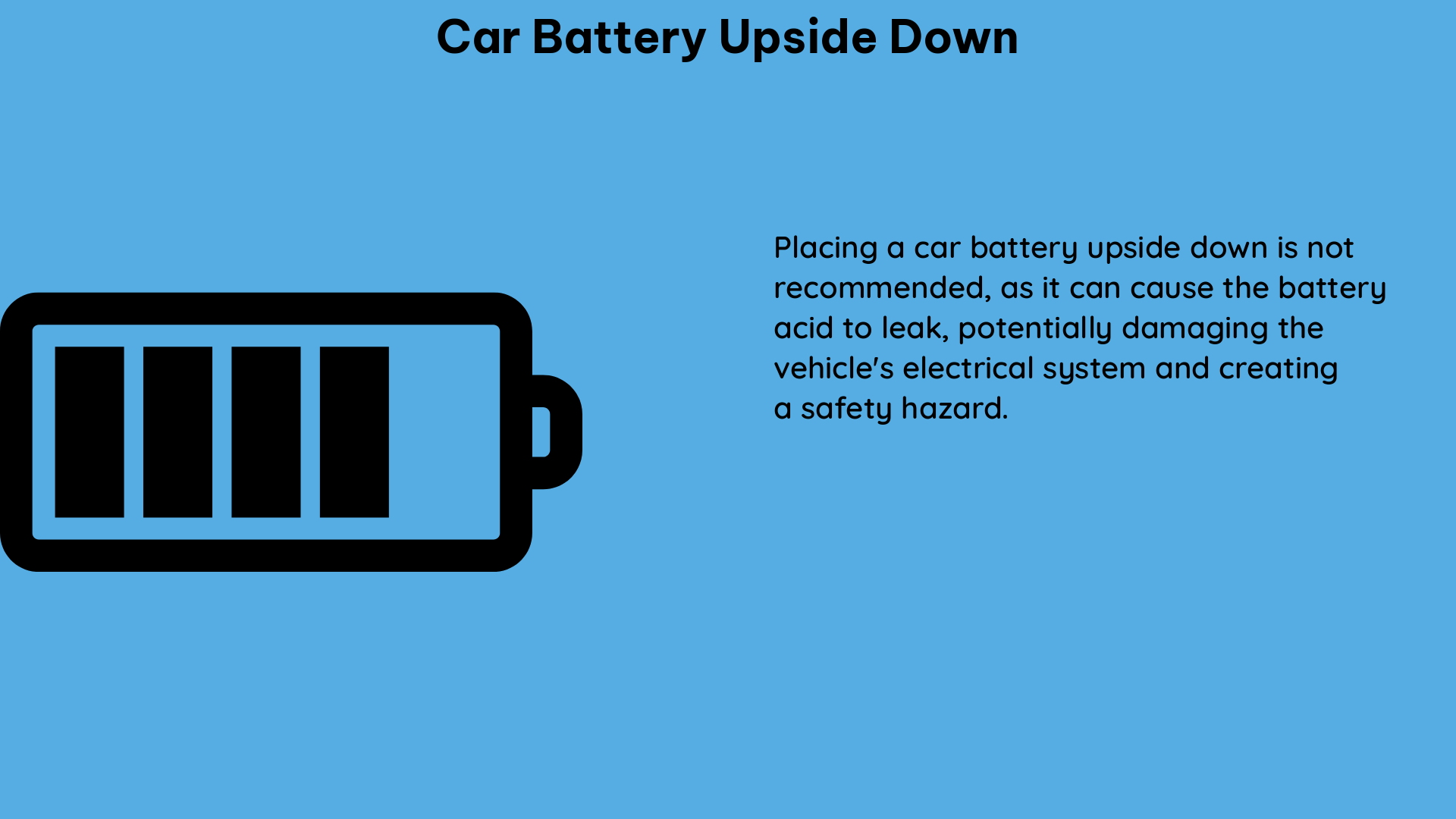Operating a car battery upside down can lead to a range of issues, primarily due to the phenomenon of acid stratification. This comprehensive guide delves into the technical details, potential consequences, and effective mitigation strategies to ensure the optimal performance and longevity of your car’s battery.
Understanding Acid Stratification
Acid stratification is a common problem that occurs in lead-acid batteries, such as those used in cars, when the battery is operated in an inverted position. This phenomenon happens when the electrolyte, a mixture of sulfuric acid and water, separates within the battery, with a higher concentration of acid at the bottom and a lower concentration at the top.
The primary cause of acid stratification is the uneven distribution of the electrolyte, which can be exacerbated by factors such as:
- Consistent Low Charge Levels: Batteries that are consistently operated at low charge levels are more susceptible to acid stratification.
- Shallow Discharges: Batteries that experience shallow discharges, rather than deep discharges, are more prone to acid stratification.
- Lack of Full Charge: Batteries that are not given a full charge on a regular basis are more likely to develop acid stratification.
- Driving Short Distances: Especially in large luxury cars, the alternator may not be able to provide a saturated charge, contributing to acid stratification.
Consequences of Acid Stratification

The uneven distribution of the electrolyte caused by acid stratification can lead to several detrimental effects on the battery’s performance and lifespan:
- Reduced Performance: Acid stratification can result in a decrease in the battery’s capacity and overall performance, as the higher concentration of acid at the bottom reduces the effective surface area of the plates.
- Corrosion: The uneven distribution of the electrolyte can lead to increased corrosion of the battery’s internal components, further reducing its lifespan.
- Higher Open-Circuit Voltage: Acid stratification can give a false indication of a fully charged battery, as the higher concentration of acid at the bottom can result in a higher open-circuit voltage.
Mitigating Acid Stratification
To address the issues caused by acid stratification in a car battery operated upside down, several mitigation strategies can be employed:
- Battery Rest: Allowing the battery to rest for a few days can help the electrolyte to redistribute and mix more evenly.
- Equalizing Charge: Applying an equalizing charge, which is a controlled overcharge, can help to mix the electrolyte and restore the battery’s performance.
- It is crucial to avoid overcharging during the equalizing charge, as this can cause excessive corrosion and damage to the battery.
- Manual Mixing: Manually mixing the electrolyte by tipping the battery on its side or performing a shaking motion can help to redistribute the acid and improve the battery’s performance.
Technical Specifications and Maintenance
To ensure the optimal performance and longevity of a car battery, it is essential to adhere to the following technical specifications and maintenance practices:
- Charge Level: A typical lead-acid battery should be kept charged, with a voltage above 2.07V/cell or a specific gravity level above 1.190.
- Avoid Deep Discharges: Deep discharges can significantly reduce the battery’s lifespan, so it is essential to avoid them.
- Electrolyte Level: The electrolyte level should be kept above the tops of the plates to prevent damage and ensure proper operation.
- Water Topping-Off: Use distilled or de-ionized water to top off the electrolyte level, as tap water can contain impurities that can harm the battery.
Conclusion
Operating a car battery upside down can lead to a range of issues, primarily due to the phenomenon of acid stratification. By understanding the causes, consequences, and mitigation strategies, you can ensure the optimal performance and longevity of your car’s battery, even in an inverted position.
Remember, regular maintenance, proper charging practices, and addressing any signs of acid stratification are crucial to maintaining a healthy and reliable car battery.
References:
- Battery University. (n.d.). BU-804c: Acid Stratification and Surface Charge – Battery University. Retrieved from https://batteryuniversity.com/article/bu-804c-acid-stratification-and-surface-charge
- Mechanics.stackexchange.com. (2020, September 20). Tipping battery upside down or it’s side? Retrieved from https://mechanics.stackexchange.com/questions/79799/tipping-battery-upside-down-or-it-s-side
- Chief Delphi. (2012, February 8). Battery upside-down – Rules/Strategy – Chief Delphi. Retrieved from https://www.chiefdelphi.com/t/battery-upside-down/118541

The lambdageeks.com Core SME Team is a group of experienced subject matter experts from diverse scientific and technical fields including Physics, Chemistry, Technology,Electronics & Electrical Engineering, Automotive, Mechanical Engineering. Our team collaborates to create high-quality, well-researched articles on a wide range of science and technology topics for the lambdageeks.com website.
All Our Senior SME are having more than 7 Years of experience in the respective fields . They are either Working Industry Professionals or assocaited With different Universities. Refer Our Authors Page to get to know About our Core SMEs.